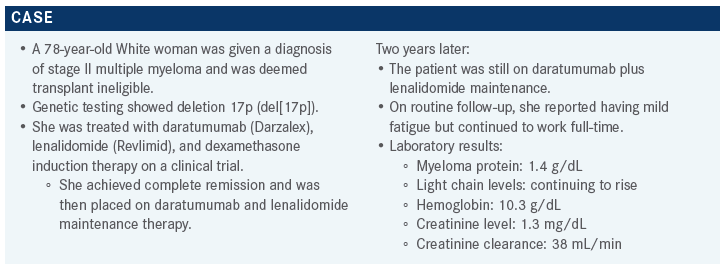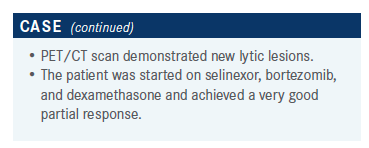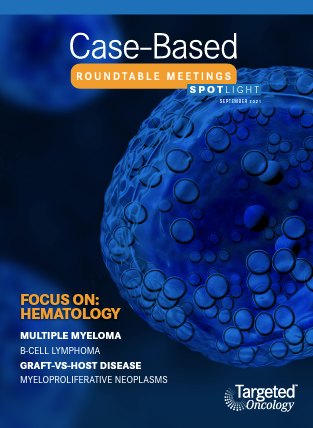Usmani Considers Possible Treatments for a Patient With Relapsed/Refractory Multiple Myeloma
Two year after being diagnosed with stage II multiple myeloma, a 78-year-old female patient was still receiving daratumumab plus lenalidomide maintenance and presented with mild fatigue during a routine follow-up.
Saad Zafar Usmani, MD


During a Targeted OncologyTM Case-Based Roundtable event, Saad Zafar Usmani, MD, director, Plasma Cell Disorder Program, and director, Clinical Research in Hematologic Malignancies at the Levine Cancer Institute, Morehead, discussed treatment options and management of toxicities for a patient with multiple myeloma.
Targeted OncologyTM: What are some drug combinations that could be considered for this patient?
USMANI: Three options that I consider reasonable are bortezomib [Velcade], pomalidomide [Pomalyst], and dexamethasone; carfilzomib [Kyprolis], pomalidomide, and dexamethasone; and selinexor [Xpovio], bortezomib, and dexamethasone.
What therapies do the National Comprehensive Cancer Network (NCCN) guidelines recommend for relapsed/refractory multiple myeloma (RRMM)?
The NCCN recommendations for RRMM include bortezomib, lenalidomide [Revlimid], and dexamethasone.1 In a study of this combination [NCT00378209], treated patients exhibited a median progression-free survival [mPFS] of 9.5 months [95% CI, 7.2-11.7]; [75% experienced PFS for at least 6 months (90% CI, 65%-84%); median follow-up, 44 months].2 The NCCN also recommends carfilzomib, lenalidomide, and dexamethasone. In a study of this combination [ASPIRE (NCT01080391)], in patients who were not lenalidomide refractory like the patient described here, mPFS was 26.3 months [HR, 0.69; 95% CI, 0.57-0.83; P = .0001; median follow-up, 32.3 months].3
Then there was the trial of the daratumumab [Darzalex]/ bortezomib/dexamethasone combination [CASTOR (NCT02136134); mPFS, not reached after a median follow-up of 7.4 months; HR, 0.39; 95% CI, 0.28-0.53; P < .001].4 The daratumumab/carfilzomib/dexamethasone combination was examined in the early-relapse setting in patients with lenalidomide-refractory disease [CANDOR, NCT03158688],5 for a median follow-up of 27.8 months [mPFS, 28.6 months; HR, 0.59; 95% CI, 0.45-0.78].6
The POLLUX trial [NCT02076009] looked at another lenalidomide/dexamethasone option, daratumumab plus lenalidomide and dexamethasone. After a median follow-up of 13.5 months, the mPFS for this study was not estimable [HR, 0.37; 95% CI, 0.27-0.52; P < .001].7 But are these data relevant to our patient? Probably not, because this is a lenalidomide-refractory patient.
[Next], we have data for the isatuximab [Sarclisa], pomalidomide, dexamethasone combination [ICARIA-MM, NCT02990338]. Following a median 11.6-month follow-up, this combination did show mPFS benefit [11.5 months (95% CI, 8.9-13.9); HR, 0.596; 95% CI, 0.44- 0.81; P = .001]. However, most of those patients had received 2 or more prior lines of treatment, a little different from our patient here.8 Also, [none of these studies] included anyone who was refractory to daratumumab like our patient.2-8
That brings us to a trial of ixazomib [Ninlaro] plus lenalidomide and dexamethasone [TOURMALINE-MM1, NCT01564537]. After a median follow-up of 14.7 months, the mPFS benefit was 20.6 months [HR, 0.74; 95% CI, 0.59-0.94; P = .01], but the study did not have any daratumumab-exposed or daratumumab-refractory patients because the study was done before the era of daratumumab.9,10 The same is true for the OPTIMISMM trial of pomalidomide plus bortezomib and dexamethasone [NCT01734928]. Even though there was an mPFS benefit favoring the experimental combination [11.20 months (95% CI, 9.66-13.73); HR, 0.61; 95% CI, 0.49-0.77; P < .0001] after a median 15.9-month follow-up, you do not find a case for our patient.11
What options exist for this patient, who is already daratumumab exposed, lenalidomide exposed, and progressing on both therapies (and therefore refractory to both drugs, according to the definition of the International Myeloma Working Group12)?
The NCCN offers a compendium of options for RRMM. Most of the category 1 options are lenalidomide based or anti-CD38 based. The options that would probably make more sense are [those involving] a proteasome inhibitor plus pomalidomide or plus something else. There are circumstances where we use cyclophosphamide [Cytoxan], bortezomib, and dexamethasone, or carfilzomib, cyclophosphamide, and dexamethasone. For the more proliferative kind of multiple myeloma, we even use [regimens involving the combination of] cisplatin, doxorubicin, cyclophosphamide, and etoposide, or [dexamethasone]- based regimens.1
The European Hematology Association and the European Society for Medical Oncology published recommendations for patients who are in their second line of treatment after daratumumab, lenalidomide, and dexamethasone.13 The recommendations were subdivided into “lenalidomide-sensitive” and “lenalidomide-refractory” categories; the lenalidomide-sensitive group represents patients who are just on daratumumab and who discontinued lenalidomide plus dexamethasone more than 3 months ago. For [the lenalidomide-sensitive] patients, you have [many] different options to consider. [However], for the lenalidomide-refractory patients, you [only have] pomalidomide, bortezomib, and dexamethasone; carfilzomib and dexamethasone; and selinexor, bortezomib, and dexamethasone. Finally, venetoclax [Venclexta], bortezomib, and dexamethasone would be an option if [the FDA approved it] for patients [with] translocation t(11;14) based on the early data that we’ve seen with the Bellini trial [NCT02755597].13,14

What is your opinion of this choice for the patient? Can you elaborate on the data that led to this option?
The right choice was made for this patient based on the BOSTON trial data [NCT03110562], and the fact that the patient had del[17p].15
I critique the BOSTON trial because a 3-drug combination [was compared with] a 2-drug combination, but I also appreciate [that at] the time when this clinical trial was designed, this was fair game. This was a randomized phase 3 study that compared [a combination of] once-weekly oral selinexor, once-weekly bortezomib given subcutaneously, and twice-weekly oral dexamethasone with twice-weekly bortezomib plus dexamethasone given 4 times per week. This dosing schedule was maintained for the first 24 weeks and resulted in 40% less bortezomib and 25% less dexamethasone in the triplet group during that period. After 24 weeks, the dosage of the doublet group was reduced to the same as that of the triplet group. The idea was to make [the triplet] regimen more tolerable. A total of 402 patients were enrolled, and there was a 1:1 randomization. The primary end point was PFS.15
The study met its primary end point. The mPFS was about 14 months [in the triplet group] and 9.46 months [in the doublet group (HR, 0.70; 95% CI, 0.53-0.93; median follow-up, 13.2 months and 16.5 months, respectively)]. But what was interesting was that the PFS benefit was consistent across most of the subgroups. The hazard ratio for progression or death was 0.38 [95% CI, 0.16- 0.86] for del[17p] patients; favorable results were also reported for patients with decreased creatinine clearance [HR, 0.49; 95% CI, 0.27-0.89], for patients younger than 65 years [HR, 0.74; 95% CI, 0.49-1.11], and for patients 65 years or older [HR, 0.55; 95% CI, 0.37-0.83].15
For the triplet group vs the doublet group, the overall response rate [76.4% (95% CI, 69.8%-82.2%) vs 62.3% (95% CI, 55.3%-68.9%), respectively] and the time it took to achieve response [1.1 months (interquartile range [IQR], 0.8-1.6 months) vs 1.4 months (IQR, 0.8-1.6 months, respectively] were superior for the triplet combination. The median duration of response was longer, as you would expect, in the selinexor arm of the study [20.3 months vs 12.9 months; HR, 0.81; 95% CI, 0.56-1.17; P = .1364].15
The most common treatment-emergent adverse event [TRAE] was thrombocytopenia [of any grade, occurring in 60% of patients; of grade 3 or 4, in 39%]. Thrombocytopenia is something that I watch for in our patients. Among nonhematological TRAEs, the most common were fatigue [of grade 3 or 4, occurring in 13%] and nausea [in 8%].15 That’s low compared with the data in the original STORM study [NCT02336815], which used a higher dose.16 I [also] think we’ve become better at managing AEs. There were early mitigation strategies in the BOSTON trial as well.15
What is your experience managing the AEs of selinexor?
My impression has been that selinexor is much better tolerated in the earlier-relapse setting with once-weekly dosing. [It’s important to have] antiemetics, specifically olanzapine, [on hand].17 Patients may require intravenous hydration if they’re having gastrointestinal AEs.17 We typically have them come in weekly during the first cycle or 2, and if they need fluids, we give them fluids. As they progress, you [only need] to see them once a month. But monitoring them closely during that first cycle or two is very important. [Also], you have to be nimble with dose modifications and [reduce] the dose if the patient has issues.17
The dose-reduction schema goes from 100 mg once weekly to 80, 60, [and finally to] 40 mg once weekly.17 I find that 60 mg ends up being the [best dose] for most of my patients; a few patients go down to 40 mg. In our experience, we haven’t had any discontinuations due to tolerability.
REFERENCES
1. NCCN. Clinical Practice Guidelines in Oncology. Multiple myeloma, version 1.2022. Accessed August 22, 2021. https://bit.ly/38qdgrk
2. Richardson PG, Xie W, Jagannath S, et al. A phase 2 trial of lenalidomide, bortezomib, and dexamethasone in patients with relapsed and relapsed/ refractory myeloma. Blood. 2014;123(10):1461-1469. doi:10.1182/ blood-2013-07-517276
3. Stewart AK, Rajkumar SV, Dimopoulos MA, et al; ASPIRE Investigators. Carfilzomib, lenalidomide, and dexamethasone for relapsed multiple myeloma. N Engl J Med. 2015;372(2):142-152. doi:10.1056/NEJMoa1411321
4. Palumbo A, Chanan-Khan A, Weisel K, et al; CASTOR Investigators. Daratumumab, bortezomib, and dexamethasone for multiple myeloma. N Engl J Med. 2016;375(8):754-766. doi:10.1056/NEJMoa1606038
5. Dimopoulos M, Quach H, Mateos MV, et al. Carfilzomib, dexamethasone, and daratumumab versus carfilzomib and dexamethasone for patients with relapsed or refractory multiple myeloma (CANDOR): results from a randomised, multicentre, open-label, phase 3 study. Lancet. 2020;396(10245):186-197. Published correction appears in Lancet. 2020;396(10249):466. doi:10.1016/ S0140-6736(20)30734-0
6. Dimopoulos MA, Quach H, Mateos MV; et al. 2325 Carfilzomib, dexamethasone,
and daratumumab vs carfilzomib and dexamethasone in relapsed or refractory multiple myeloma: updated efficacy and safety results of the phase 3 Candor study. Paper presented at: 62nd American Society of Hematology Annual Meeting and Exposition; December 5-8, 2020; virtual. Accessed August 24, 2021. https://bit.ly/3zB5sPm
7. Dimopoulos MA, Oriol A, Nahi H, et al; POLLUX Investigators. Daratumumab, lenalidomide, and dexamethasone for multiple myeloma. N Engl J Med. 2016;375(14):1319-1331. doi:10.1056/NEJMoa1607751
8. Attal M, Richardson PG, Rajkumar SV, et al; ICARIA-MM Study Group. Isatuximab plus pomalidomide and low-dose dexamethasone versus pomalidomide and low-dose dexamethasone in patients with relapsed and refractory multiple myeloma (ICARIA-MM): a randomised, multicentre, open-label, phase 3 study. Lancet. 2019;394(10214):2096-2107. doi:10.1016/S0140-6736(19)32556-5
9. Moreau P, Masszi T, Grzasko N, et al; TOURMALINE-MM1 Study Group. Oral ixazomib, lenalidomide, and dexamethasone for multiple myeloma. N Engl J Med. 2016;374(17):1621-1634. doi:10.1056/NEJMoa1516282
10. Daratumumab (Darzalex). FDA. Updated November 22, 2016. Accessed August 31, 2021. https://bit.ly/3BsWX9Q
11. Richardson PG, Oriol A, Beksac M, et al; OPTIMISMM Trial Investigators. Pomalidomide, bortezomib, and dexamethasone for patients with relapsed or refractory multiple myeloma previously treated with lenalidomide (OPTIMISMM): a randomised, open-label, phase 3 trial. Lancet Oncol. 2019;20(6):781-794. doi:10.1016/S1470-2045(19)30152-4
12. Rajkumar SV, Harousseau JL, Durie B, et al; International Myeloma Workshop Consensus Panel 1. Consensus recommendations for the uniform reporting of clinical trials: report of the International Myeloma Workshop Consensus Panel 1. Blood. 2011;117(18):4691-4695. doi:10.1182/blood-2010-10-299487
13. Dimopoulos MA, Moreau P, Terpos E, et al; European Hematology Association Guidelines Committee; European Society for Medical Oncology Guidelines Committee. Multiple myeloma: EHA-ESMO clinical practice guidelines for diagnosis, treatment and follow-up. Ann Oncol. 2021;32(3):309-322. doi:10.1016/j. annonc.2020.11.014
14. Kumar SK, Harrison SJ, Cavo M, et al. Venetoclax or placebo in combination with bortezomib and dexamethasone in patients with relapsed or refractory multiple myeloma (BELLINI): a randomised, double-blind, multicentre, phase 3 trial. Lancet Oncol. 2020;21(12):1630-1642. doi:10.1016/ S1470-2045(20)30525-8
15. Grosicki S, Simonova M, Spicka I, et al. Once-per-week selinexor, bortezomib, and dexamethasone vs twice-per-week bortezomib and dexamethasone in patients with multiple myeloma (BOSTON): a randomised, open-label, phase 3 trial. Lancet. 2020;396(10262):1563-1573. doi:10.1016/ S0140-6736(20)32292-3
16. Chari A, Vogl DT, Gavriatopoulou M, et al. Oral selinexor-dexamethasone for triple-class refractory multiple myeloma. N Engl J Med. 2019;381(8):727-738. doi:10.1056/NEJMoa1903455
17. Xpovio. Prescribing information. Karyopharm Therapeutics Inc; 2020. Accessed August 23, 2021. https://bit.ly/3zAqJJ3

Age, Disease Burden Are Factors in Early Use of Selinexor in Multiple Myeloma
April 22nd 2024During a Case-Based Roundtable® event, Jonathan L. Kaufman, MD, discussed treatment approaches and the tolerability of a selinexor-containing regimen in a patient with relapsed/refractory multiple myeloma in the first article of a 2-part series.
Read More